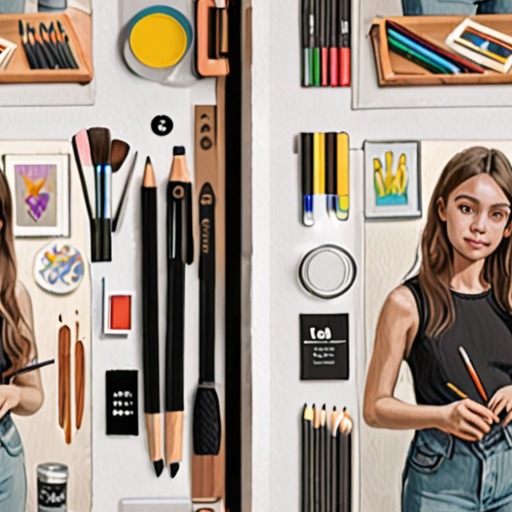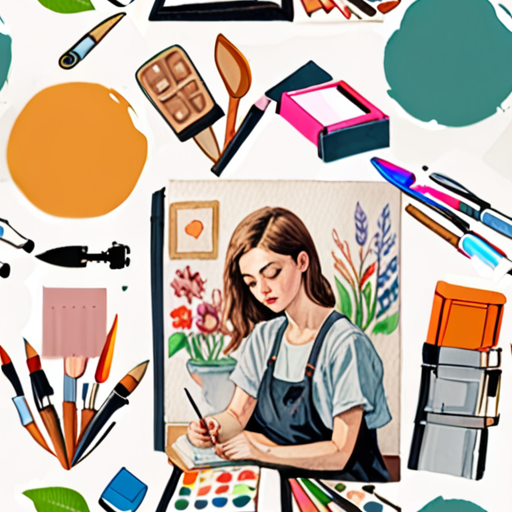In the vibrant world of art, finding the right art materials for beginners can be both exciting and overwhelming. Whether you’re embarking on your first artistic journey or refining your burgeoning skills, understanding the fundamentals through the best drawing supplies can turn the daunting into the doable. This article delves into essential art materials for beginners, guiding you through the myriad of choices—from basic drawing tools to sketch supplies and beginner art supplies. From grasping color theory and selecting the right brushes to exploring the 7 essentials of art and rules such as the 1/3, golden, and 60/40 principles, we’re here to equip you with knowledge and inspiration. Discover top art tutorials for beginners, tips on maintaining motivation, and ways to foster your growth as an artist, all while navigating the beginner art supplies landscape with ease. Whether online or locally, the right art materials can pave the way to mastery, while drawing tutorials for beginners serve as a valuable resource as you learn how to draw for beginners. Let’s dive into the world of art and draw your dreams into reality with the best art supplies for beginners.
What Are the Best Art Supplies for Beginners?
As an artist, choosing the right art supplies can be overwhelming, especially for those just starting out.
- Pencils: Invest in a set of graphite pencils (HB, 2B, 4B, 6B) and colored pencils (24-pack) from reputable brands like Faber-Castell or Prismacolor.
- Sketchbooks: Look for high-quality sketchbooks made from durable paper, such as Canson or Strathmore.
- Paints: Explore watercolor paints from Winsor & Newton or Daniel Smith, and acrylic paints from Golden or Liquitex.
- Bristle Brushes: Choose synthetic brushes from Daler-Rowney or Winsor & Newton for oil and acrylic painting.
- Canvas: Opt for cotton canvas from Fredrix or Daler-Rowney for oil and acrylic painting.
When selecting art supplies, consider factors like quality, durability, and price. As a beginner, it’s essential to invest in basic materials that will last long-term.
Tips for Choosing the Right Art Supplies
- Research: Read reviews, watch tutorials, and consult with fellow artists to gain insight into the best art supplies for your needs.
- Quality Over Price: Prioritize investing in high-quality art supplies that will withstand frequent use.
- Try out different materials and techniques to discover what works best for you.
- Regularly practice drawing and painting to develop your skills and become comfortable with your chosen art supplies.
Additional Resources
For more information on art supplies and techniques, visit our Resources Page or explore online communities like DeviantArt and ArtStation .
The 7 Essentials of Art
As an artist, understanding the fundamental principles of art is crucial for creating visually appealing and meaningful pieces.
- Line
- Shape
- Space
- Value
- Form
- Texture
- Color
A line is a continuous mark made on a surface by a drawing tool. Lines can vary in width, length, direction, and curvature, and are used to define shape, form, and movement in a composition.
A shape is a self-contained area with a defined boundary. Shapes can be geometric, such as circles and squares, or organic, like free-form shapes found in nature.
Space refers to the negative areas between and around objects in a composition. Space can be used to create a sense of depth, distance, and atmosphere in a piece of art.
Value refers to the lightness or darkness of a color or object in a composition. Value can be used to create contrast, hierarchy, and mood in a piece of art.
Form refers to the three-dimensional qualities of an object or shape. Form can be created through the use of lines, values, and textures to suggest volume and mass.
Texture refers to the surface quality or “feel” of an object or material. Texture can be physical, like the roughness of stone, or visual, like the smoothness of glass.
Color is a property of light that is perceived by the eye. Color can be used to evoke emotions, convey meaning, and create harmony or contrast in a composition.
By mastering these 7 essentials of art, artists can create powerful and expressive works that engage and inspire audiences.

What to Buy as a Beginner Artist
As a beginner artist, investing in the right art supplies can make a significant difference in your creative journey.
- Paper:
- Sketch paper (cold press or hot press)
- Watercolor paper (cold press or hot press)
- Canson Mi-Teintes paper (for mixed media)
- Pencils:
- Graphite pencils (#2, HB, 6B)
- Drawing pencils (charcoal, pastel)
- Colored pencils (Wax-based or oil-based)
- Eraser:
- Kneaded eraser
- Vinegar eraser
- White eraser (for correcting mistakes)
- Pen:
- Fountain pen (for ink drawing)
- Rollerball pen (for ink drawing)
- Fineliners (for detail work)
- Paint:
- Acrylic paint (basic colors)
- Oil paint (basic colors)
- Watercolor paint (pan set or tube set)
- Other Supplies:
- Easel ( tabletop or standing)
- Palette ( disposable or reusable)
- Rags (lint-free)
- Paintbrushes (various sizes and shapes)
- Tape (masking or painter’s tape)
Remember, these are just basic supplies to get you started. Feel free to experiment and explore different materials as you become more comfortable with your craft.
For more information on art supplies and techniques, visit our Art Supplies page or check out our Tutorials section for step-by-step guides and tips.

The 13 Rules in Art
The 13 rules in art refer to a set of guidelines developed by John Raynes, a British artist and educator, which aim to provide a framework for creating balanced and visually appealing compositions.
- Rule 1: Balance – The placement of visual elements in a composition should be balanced to create a sense of stability and harmony.
- Rule 2: Contrast – The use of contrasting colors, shapes, and textures can add interest and depth to a composition.
- Rule 3: Emphasis – A strong central element or focal point should be used to draw the viewer’s attention.
- Rule 4: Movement – The direction and movement of visual elements can guide the viewer’s eye through the composition.
- Rule 5: Pattern – Repeating patterns can create a sense of rhythm and unity in a composition.
- Rule 6: Unity – A consistent style or theme can tie together disparate elements and create a cohesive whole.
- Rule 7: Proportion – The size and scale of visual elements should be proportional to each other and to the overall composition.
- Rule 8: Alignment – Visual elements should be aligned in a way that creates a sense of order and balance.
- Rule 9: Color Harmony – Colors should be chosen to create a harmonious and visually appealing palette.
- Rule 10: Value – The use of light and dark values can add depth and dimensionality to a composition.
- Rule 11: Texture – Different textures can add interest and tactile quality to a composition.
- Rule 12: Shape – The use of geometric and organic shapes can create a dynamic and engaging composition.
- Rule 13: Space – Negative space can be used to create a sense of breathing room and visual balance.
By applying these 13 rules, artists can create compositions that are visually appealing, balanced, and effective in communicating their intended message.
The Golden Rule in Art
The golden rule in art refers to the concept of achieving balance and harmony through the use of mathematical proportions.
- The most commonly referenced proportion is the golden ratio, which is approximately equal to 1.618033988749895.
- This ratio is believed to possess unique aesthetic properties that can evoke feelings of beauty and balance in the human mind.
- In art, the golden ratio is often used to create compositions that are visually appealing and harmonious.
Artists have long been fascinated by the golden ratio and its potential to enhance the beauty and impact of their work.
- By incorporating the golden ratio into their compositions, artists can create a sense of balance and harmony that engages the viewer’s eye and draws attention to key elements of the artwork.
- The golden ratio can also be used to create a sense of tension and contrast, adding depth and interest to a composition.
- Furthermore, the golden ratio has been shown to have a profound effect on the human psyche, evoking feelings of calmness, serenity, and even spiritual connection.
As an artist, understanding and applying the golden ratio can be a powerful tool for creating works that resonate with viewers on a deep level.
Applying the Golden Ratio in Art
To apply the golden ratio in art, consider the following tips:
- Measure the proportions of your composition using a ruler or software to ensure that the golden ratio is present.
- Use the golden ratio to determine the placement of key elements, such as the subject’s eyes or the center of interest.
- Experiment with different ratios and proportions to find what works best for your particular style and vision.
Conclusion
By embracing the golden ratio and its principles, artists can unlock new levels of creativity and expression, crafting works that captivate and inspire audiences worldwide.

The 60/40 Rule in Art
The 60/40 rule in art refers to a composition technique used to balance light and dark elements in a scene.
- According to this rule, the sunlit areas of a scene should occupy approximately 60% of the space, while the shaded areas should take up around 40%
- This ratio can be applied to various aspects of a composition, such as the placement of objects, colors, and textures
- By applying the 60/40 rule, artists can create a sense of balance and harmony in their work, drawing the viewer’s eye to the most important elements
Applying the 60/40 Rule
To apply the 60/40 rule effectively, consider the following tips:
- Determine the focal point of your composition and allocate 40% of the space to it
- Divide the remaining 60% between the surrounding elements, taking care to balance light and dark areas
- Experiment with different ratios and compositions to find the perfect balance for your artwork
Benefits of the 60/40 Rule
The 60/40 rule offers several benefits for artists, including:
- Improved composition and balance
- Enhanced visual interest and engagement
- Increased emotional impact and connection with the viewer
Conclusion
The 60/40 rule is a powerful tool for artists looking to create balanced and harmonious compositions. By understanding and applying this principle, artists can elevate their work and connect with their audience on a deeper level.

0 Comments